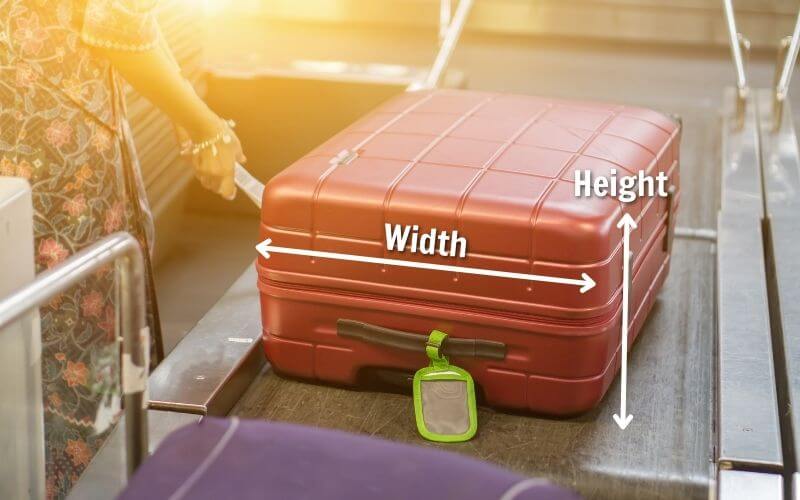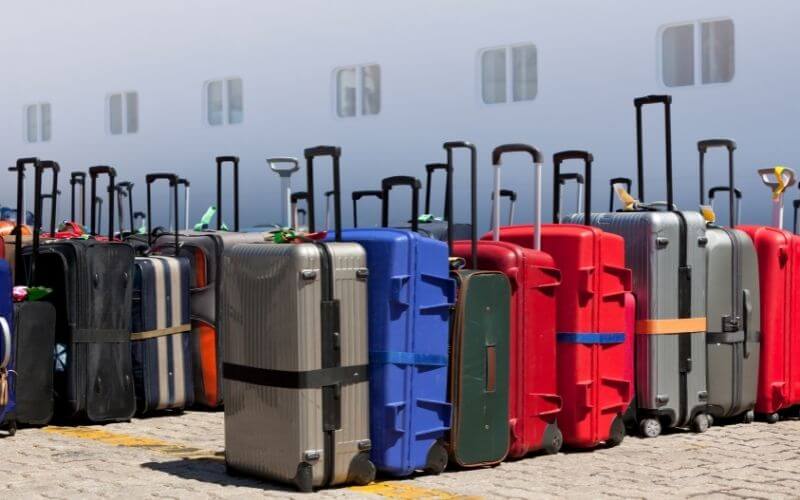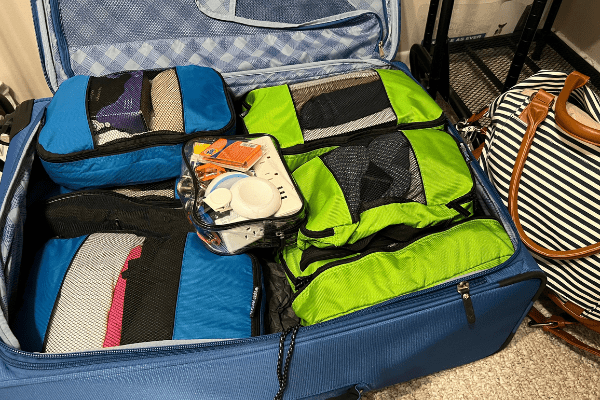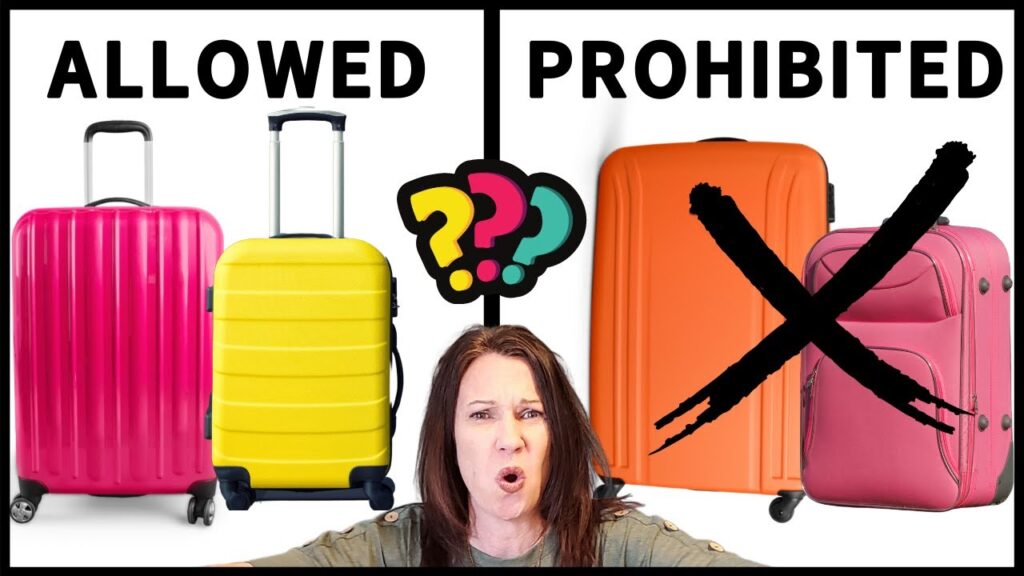Planning a cruise vacation? It’s important to be aware of the luggage restrictions that come with it. From weight limits to prohibited items, understanding what you can and cannot bring on board will ensure a hassle-free travel experience. Whether you’re a first-time cruiser or a seasoned explorer, this article will provide you with all the essential information you need to know about luggage restrictions on a cruise. So sit back, relax, and let’s dive into the world of packing for your dream cruise getaway!
1. Size and weight restrictions
1.1 Carry-on luggage size and weight
When it comes to carry-on luggage on a cruise, size and weight restrictions can vary depending on the cruise line and destination. Most cruise lines allow passengers to bring one carry-on bag with them. The general size limit for carry-on bags is usually around 22 x 14 x 9 inches (approx. 56 x 36 x 23 cm). However, it is important to check with your specific cruise line for their specific guidelines, as some may have slightly different size restrictions.
In terms of weight, most cruise lines do not have strict weight limits for carry-on bags. However, it is important to keep in mind that you will have to carry your bag around with you, so it is generally best to keep it light and manageable.
1.2 Checked luggage size and weight
When it comes to checked luggage on a cruise, the size and weight restrictions can vary depending on the cruise line and destination. The general size limit for checked bags is usually around 62 inches (total linear dimensions). This is calculated by adding together the height, width, and length of the bag.
As for weight restrictions, most cruise lines have a maximum weight limit of around 50 pounds (approx. 23 kilograms) per bag. Again, it is important to check with your specific cruise line for their exact guidelines, as some may have slightly different allowances.
1.3 Oversized and overweight luggage
If you plan on bringing oversized or overweight luggage on a cruise, it is important to contact your cruise line in advance. Each cruise line will have its own policies and procedures for handling oversized or overweight luggage. In some cases, additional fees may apply, and advance notice may be required.
If you have oversized or overweight items that exceed the standard size and weight restrictions, it is important to make arrangements with your cruise line ahead of time to ensure a smooth embarkation process.
2. Prohibited items
2.1 Weapons and dangerous objects
For safety reasons, cruise lines have strict policies regarding weapons and dangerous objects. It is important to note that weapons, firearms, ammunition, and explosives are strictly prohibited on board. This includes items such as firearms, knives, stun guns, and other similar devices.
If you accidentally bring any prohibited items with you, it is important to inform the cruise line immediately. They will be able to guide you on how to properly dispose of or secure the item.
2.2 Illegal substances
Bringing illegal substances on a cruise is not only against the rules but also against the law. Cruise lines have a zero-tolerance policy when it comes to illegal drugs and substances. Passengers found in possession or using illegal substances may be disembarked from the cruise and may face legal consequences.
It is always important to familiarize yourself with the cruise line’s policies regarding illegal substances before embarking on your cruise.
2.3 Explosives and flammable materials
In order to ensure safety on board, explosives and flammable materials are strictly prohibited on cruise ships. This includes items such as fireworks, flares, propane tanks, and other similar items. These restrictions are in place to prevent any potential accidents or fires on board.
If you have any questions about specific items you plan to bring or are unsure if something falls under the category of explosives or flammable materials, it is best to contact the cruise line for clarification.
2.4 Firearms and ammunition
Firearms and ammunition are strictly prohibited on cruise ships. Cruise lines have strict security measures in place, and bringing firearms or ammunition on board is not allowed. This includes both handguns and long guns.
If you are a law enforcement officer or have a valid reason for traveling with firearms, it is important to contact the cruise line in advance to make the necessary arrangements.
2.5 Liquids and aerosols
Like with air travel, cruise lines have restrictions on liquids and aerosols. Most cruise lines follow the Transportation Security Administration (TSA) regulations when it comes to liquids and aerosols. The general rule is that liquids must be in containers that are 3.4 ounces (100 milliliters) or less, and all containers must fit into a single quart-sized (approx. 1 liter) clear plastic bag.
It is important to note that these restrictions generally apply to items in your carry-on luggage. Checked luggage may have fewer restrictions on liquids and aerosols, but it is still best to check with your specific cruise line for their guidelines.

This image is property of www.cruisemummy.co.uk.
3. Liquor and alcohol restrictions
3.1 Bringing your own alcohol
Bringing your own alcohol on a cruise is generally restricted. Most cruise lines have policies in place that prohibit passengers from bringing their own alcohol on board. This is because cruise lines often have bars, lounges, and other venues where they sell alcoholic beverages, and bringing your own alcohol may impact those sales.
It is important to check with your specific cruise line for their policies regarding bringing your own alcohol. Some cruise lines may allow a limited amount of alcohol to be brought on board, while others may not allow any at all.
3.2 Purchasing alcohol on board
While bringing your own alcohol may be restricted, most cruise lines have onboard shops where passengers can purchase alcoholic beverages. These shops usually offer a variety of wines, spirits, and other alcoholic beverages for purchase, which can be enjoyed in your stateroom or in designated areas on the ship.
Cruise lines often have duty-free shops where passengers can take advantage of reduced prices. It is important to note that any alcohol purchased on board may be subject to taxes and fees, so it is always best to check with the cruise line for any applicable regulations.
3.3 Limitations on consumption
While cruise lines may allow passengers to purchase and consume alcohol on board, there are often limitations in place to ensure responsible drinking. These limitations may include age restrictions, restrictions on the amount of alcohol that can be consumed, and restrictions on where alcohol can be consumed.
It is important to familiarize yourself with the specific alcohol consumption policies of your chosen cruise line to ensure a safe and enjoyable experience for everyone on board.
4. Medications and medical equipment
4.1 Prescription medications
If you require prescription medications, it is important to bring an adequate supply with you on your cruise. It is best to pack your prescription medications in your carry-on luggage, as checked luggage may be subject to delays or loss.
To avoid any potential issues, it is also recommended to bring a copy of your prescription or a note from your healthcare provider stating the need for the medication. This can be helpful in case there are any questions or concerns during the embarkation or disembarkation process.
4.2 Over-the-counter medications
In addition to prescription medications, it is also a good idea to bring any necessary over-the-counter medications with you on your cruise. This could include items such as pain relievers, allergy medication, motion sickness medication, and any other medications you may need during your trip.
Again, it is recommended to pack these medications in your carry-on luggage for easy access and to ensure they are not lost or delayed.
4.3 Medical equipment and supplies
If you require medical equipment or supplies, it is important to contact your cruise line in advance to make any necessary arrangements. This could include items such as wheelchair accessibility, oxygen tanks, or any other medical equipment or supplies you may need during your cruise.
Cruise lines are usually well-equipped to handle medical needs, but it is best to inform them in advance to ensure a smooth and comfortable experience on board.

This image is property of www.cruisemummy.co.uk.
5. Special considerations for specialty cruises
5.1 Adventure and expedition cruises
For adventure and expedition cruises, it is important to pack appropriately for the activities and excursions you will be participating in. This may include items such as hiking boots, rain gear, appropriate clothing for different climates, and any necessary equipment for specific activities.
It is also recommended to check with the cruise line for any specific gear requirements or recommendations for the activities you plan to participate in.
5.2 Theme and party cruises
Theme and party cruises often have specific dress codes or costume requirements. It is important to check with the cruise line or event organizer for any specific guidelines or recommendations for these types of cruises.
These cruises can be a fun and unique experience, but it is best to come prepared by packing appropriate attire or costumes to fully enjoy the festivities.
5.3 River cruises
River cruises may have specific considerations in terms of luggage size and weight due to the smaller size of the ships. It is important to check with the cruise line for any specific guidelines or restrictions regarding luggage on river cruises.
In addition, river cruises often involve different types of excursions and activities, such as walking tours or visits to smaller towns. It is best to pack comfortable walking shoes and lightweight clothing suitable for these types of activities.
6. Accessibility and disability-related restrictions
6.1 Wheelchair accessibility
Cruise lines are generally equipped to accommodate passengers with disabilities and provide wheelchair accessibility. It is important to contact your specific cruise line in advance to discuss any specific needs or requirements you may have.
Cruise ships are designed to be wheelchair accessible, with features such as ramps, elevators, and wider doorways. However, it is always best to inform the cruise line in advance to ensure a smooth and comfortable experience on board.
6.2 Mobility aids and assistive devices
If you require mobility aids or other assistive devices, it is important to inform your cruise line in advance. This could include items such as walkers, canes, or personal scooters.
Cruise lines may have specific guidelines or restrictions regarding the use of these devices on board, so it is best to check with your specific cruise line to ensure a seamless experience.

This image is property of lifewellcruised.com.
7. Air travel and luggage
7.1 Pre-cruise air travel
If you are traveling to your cruise departure port by air, it is important to consider the airline’s specific luggage restrictions as well. Airlines often have their own size, weight, and liquid restrictions for both carry-on and checked luggage.
To ensure a smooth transition from air travel to your cruise, it is recommended to pack your cruise essentials in your carry-on luggage and check the rest. This way, you will have access to your necessary items in case of any delays or lost luggage.
7.2 Checked baggage fees
Some airlines charge fees for checked baggage, and these fees can vary depending on the airline and destination. It is important to check with your specific airline for their policies and any applicable fees.
If you are concerned about checked baggage fees, it may be worth considering packing light and fitting everything into your carry-on luggage to avoid any additional costs.
7.3 Connecting flights
If you have connecting flights on your way to your cruise departure port, it is important to consider the overall travel time and potential delays. It is recommended to leave sufficient time between flights to avoid any stress or potential issues with getting to your cruise on time.
When packing, it is also a good idea to pack essential items and a change of clothes in your carry-on luggage, just in case your checked luggage does not make it to your final destination on time.
8. Storage and security
8.1 Onboard storage options
Cruise ships typically have ample storage options in each stateroom to accommodate your belongings. This can include closets, drawers, shelves, and under-bed storage. However, the amount of storage may vary depending on the size and type of stateroom you have booked.
To make the most of the available storage space, it is recommended to pack your items in packing cubes or compression bags. This can help optimize space and keep your belongings organized during your voyage.
8.2 Safe and secure storage
While cruise ships strive to provide a safe and secure environment, it is always a good idea to take precautions when it comes to securing your valuables. Most cruise ships provide in-room safes where you can store valuable items such as passports, cash, and jewelry.
It is important to use the safe provided and not leave valuable items unattended in your stateroom. Additionally, it is recommended to travel with travel insurance that covers loss or theft of personal belongings.
8.3 Tracking and identification
To help with luggage identification and tracking, it is a good idea to attach a luggage tag with your name, contact information, and stateroom number to each of your bags. This can make it easier for the cruise line staff to locate and deliver your luggage to your stateroom.
In addition, it may be worthwhile to take photos of your luggage before and after the cruise. This can serve as documentation in case of any potential issues or disputes regarding lost or damaged luggage.

This image is property of i.ytimg.com.
9. Handling and delivery of luggage
9.1 Embarkation and disembarkation process
During the embarkation process, you will need to hand over your checked luggage to the cruise line staff. They will then deliver your luggage to your assigned stateroom. It is important to ensure that your luggage is properly tagged and that you have removed any prohibited items before handing it over.
At the end of the cruise, during the disembarkation process, you will need to place your checked luggage outside your stateroom the night before leaving the ship. The cruise line staff will collect it and arrange for its retrieval after you have disembarked.
9.2 Luggage delivery to stateroom
Once you have boarded the ship, it may take some time for your checked luggage to be delivered to your stateroom. This is because the cruise line staff needs to handle a large number of bags and ensure they are delivered to the correct rooms.
To make the transition smoother, it is recommended to pack essential items in your carry-on luggage, such as medications, toiletries, a change of clothes, and any other items you may need immediately upon boarding the ship.
9.3 Handling of fragile items
If you have any fragile or delicate items that you plan to bring on your cruise, it is important to take extra precautions to protect them. This could include packing them in bubble wrap or foam, placing them in a hard-shell suitcase or carry-on bag, or even shipping them to your destination in advance.
It is important to inform the cruise line staff if you have any fragile items in your luggage, as they may be able to handle them with additional care during the handling and delivery process.
10. Tips and recommendations for packing
10.1 Pack light and efficiently
Packing light and efficiently can make your cruise experience much more enjoyable. Consider the duration of your cruise and pack accordingly. Mix-and-match clothing items that can be worn in different combinations to minimize the number of outfits you need to bring.
It is also important to consider the activities and dress codes on board and pack appropriate clothing. Many cruise lines have a mix of casual, formal, and theme nights, so it is best to plan your outfits accordingly.
10.2 Essential items to bring
In addition to packing light, there are certain essential items that you should consider bringing on your cruise. These may include sunscreen, a hat, sunglasses, a reusable water bottle, a swimsuit, comfortable walking shoes, and any necessary personal hygiene products.
It is also a good idea to bring a small First Aid kit with basic medical supplies, such as band-aids, pain relievers, and over-the-counter medications for common ailments.
10.3 Pack for different climates and activities
Depending on your cruise itinerary, you may be visiting different destinations with varying climates. It is important to pack clothing suitable for different weather conditions and activities.
This could include items such as lightweight and breathable clothing for warm destinations, layers for cooler climates, and rain gear for destinations with higher precipitation. It is also a good idea to check the weather forecast for each destination ahead of time to ensure you pack appropriately.
In conclusion, understanding and adhering to the luggage restrictions on a cruise is important for a smooth and enjoyable experience. From size and weight restrictions to prohibited items and special considerations for different types of cruises, it is important to be well-prepared and informed. By following the guidelines provided by your specific cruise line and considering essential items and efficient packing techniques, you can ensure that your cruise vacation is hassle-free and memorable.

This image is property of lifewellcruised.com.
Hi, I’m Mike, the author of Ocean Bliss Journeys. Thank you for visiting 🙂

